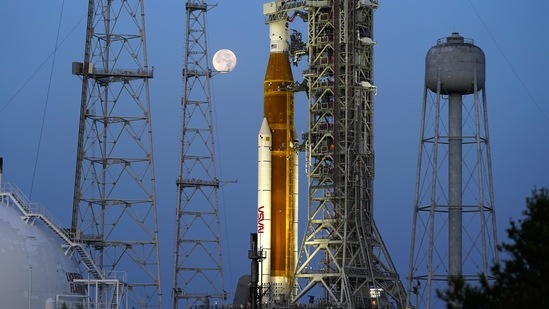Artemis I launch: All eyes on NASA's mega-moon mission | Top updates
Artemis I launch: If successful, NASA's Artemis mission will put humans on the moon for the first time since the two-man descent team of 1972 on Apollo 17.
The liftoff of US space agency NASA's uncrewed next-generation Artemis I moon mission rocket - slated for Monday - has grabbed wide attention amid massive anticipation. Launch teams reached the Kennedy Space Center in Florida and spent a final full day of preparations ahead of the much-awaited launch of the debut test flight, kicking off the first Moon-to-Mars program, 50 years after the end of the Apollo mission. Weather forecasters have sounded 80 per cent chances of favourable conditions for the rocket launch. "Everything to date looks good from a vehicle perspective," said Jeff Spaulding, senior NASA test director for the landmark uncrewed Artemis mission. "We are excited, the vehicle is ready, it looks great." The Artemis I launch is set for 8:33am EDT (6:03pm IST).

How to watch
The Artemis I launch to the moon will be live telecasted on NASA TV as well as NASA's official YouTube page. Click here to head to the live link.
Struck by lightning
Just two days before the launch, on Saturday, lightning rods at the launch site were struck during a storm, Spaulding told Reuters, adding he had not "seen anything on the ground systems that give us any concerns."
Later NASA said there was no damage caused to the spacecraft or launch facilities in the incident.
Key details:
- The Space Launch System (SLS) rocket is set to propel an uncrewed capsule named Orion around the moon and back on a six-week test flight designed to put both vehicles through their paces before flying astronauts in a subsequent mission targeted for 2024.
- The SLS-Orion combo, standing 322 feet (98 meters) tall, form the centerpiece of the US space agency's successor to the Apollo moon program of the 1960s and 1970s.
- Between 100,000 and 200,000 visitors are expected to attend the launch of Artemis 1, the first test for future crewed flights, in Florida. "The plan is to drive very early in the morning and get a spot" on Cocoa Beach, said a tourist, speaking to AFP. “I know it's going to be from a far distance, but I still think it's going to be a sight to behold.”
- The SLS for Artemis program has been under development for more than a decade due to delays and cost overturns. It has, however, generated tens of thousands of jobs and billions of dollars in commerce under the primary contractors Boeing Co for SLS and Lockheed Martin Corp for Orion.
- This is the first humans-on-moon mission since Apollo 17, the two-man descent team of 1972.
- If these missions complete successfully, NASA will begin its plan to land astronauts back on the moon, including the first woman to set foot on the lunar surface, as early as 2025.
- The ultimate goal behind NASA's Artemis program is to eventually establish a long-term lunar base as a stepping stone to even more ambitious astronaut voyages to Mars, for which the space agency has said will probably take until at least the late 2030s to achieve.
- NASA officials are cautious about the only concern they have before the maiden test flight – a potential, but minor, helium leak in launch pad equipment. This, Spaulding was quoted by Reuters as saying, is not expected to cause any technical show-stoppers to the countdown.
(With agency inputs)






